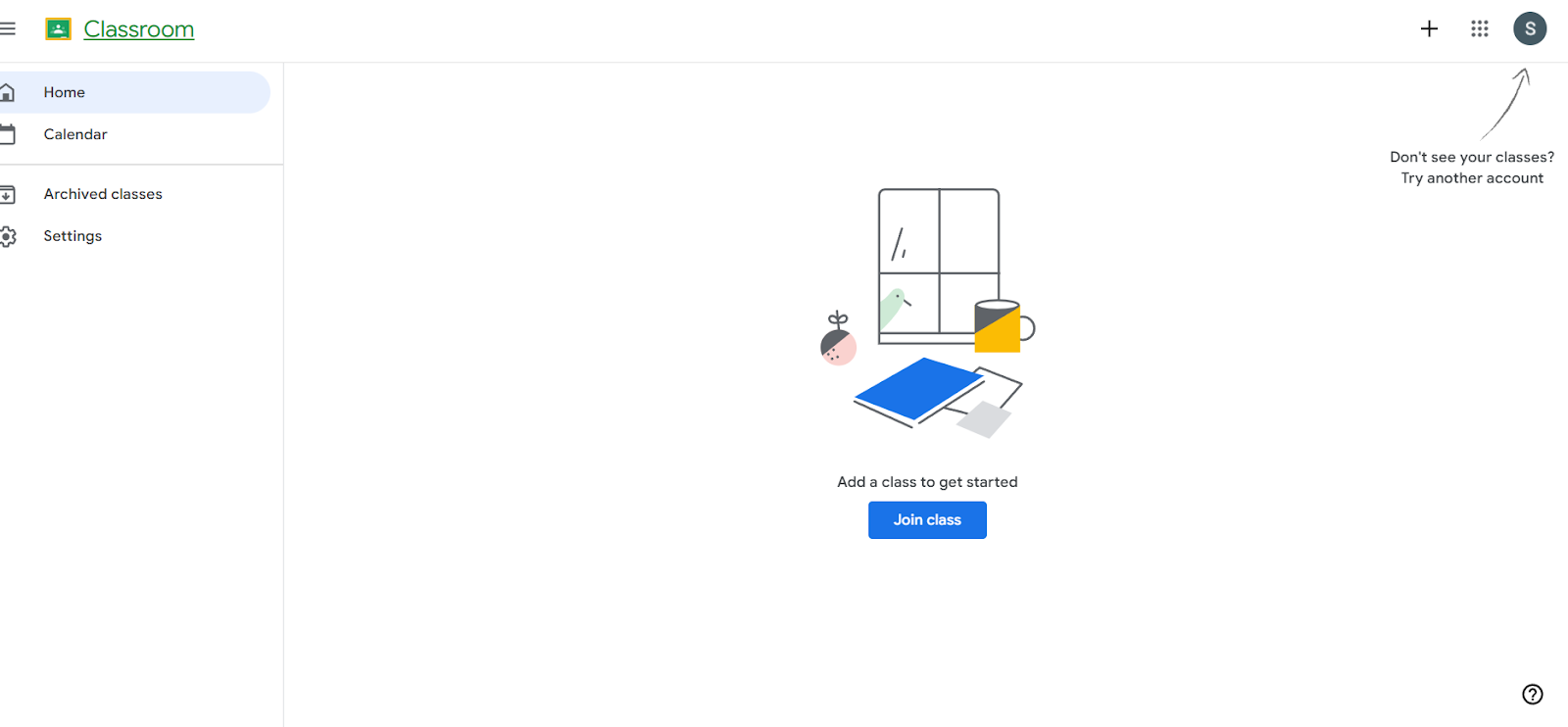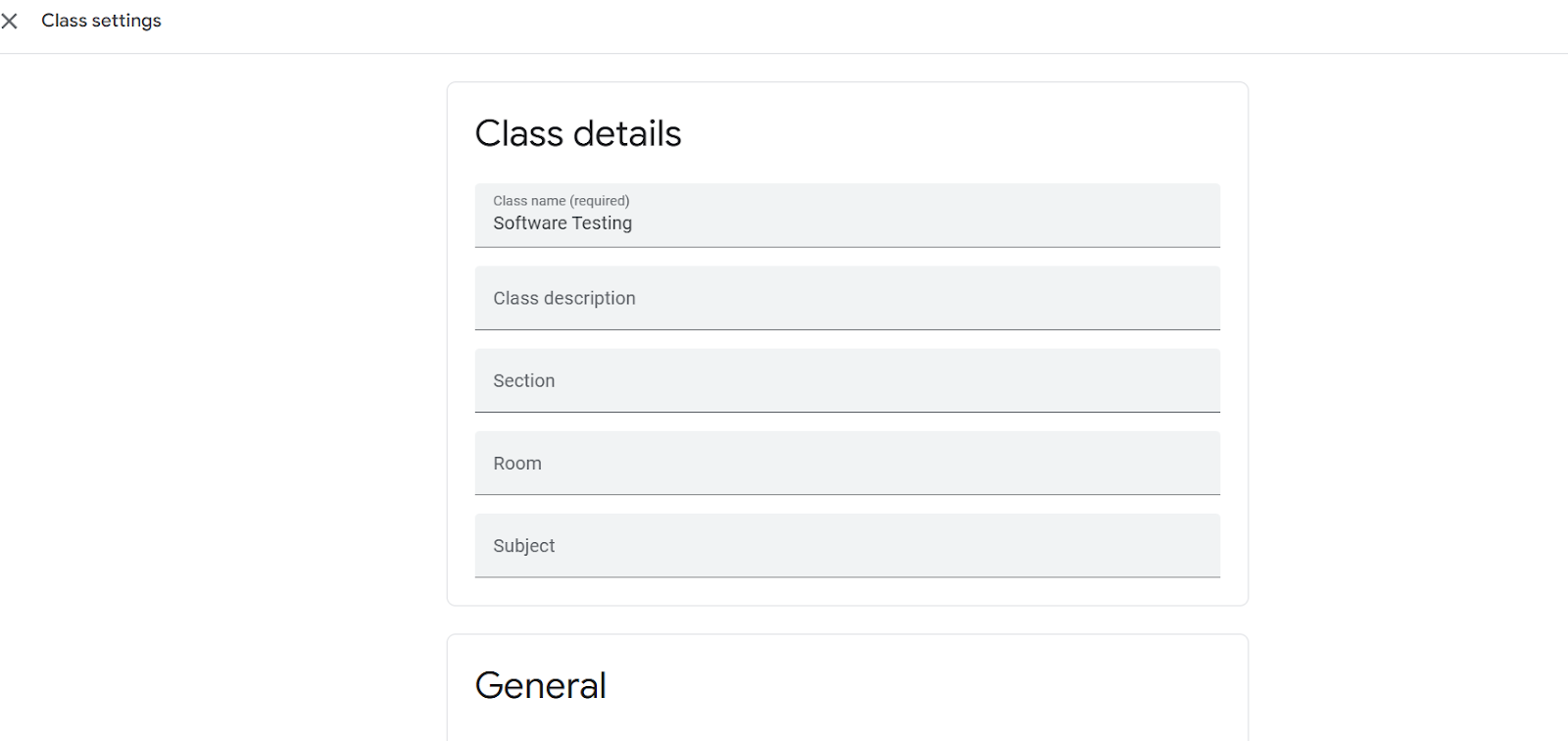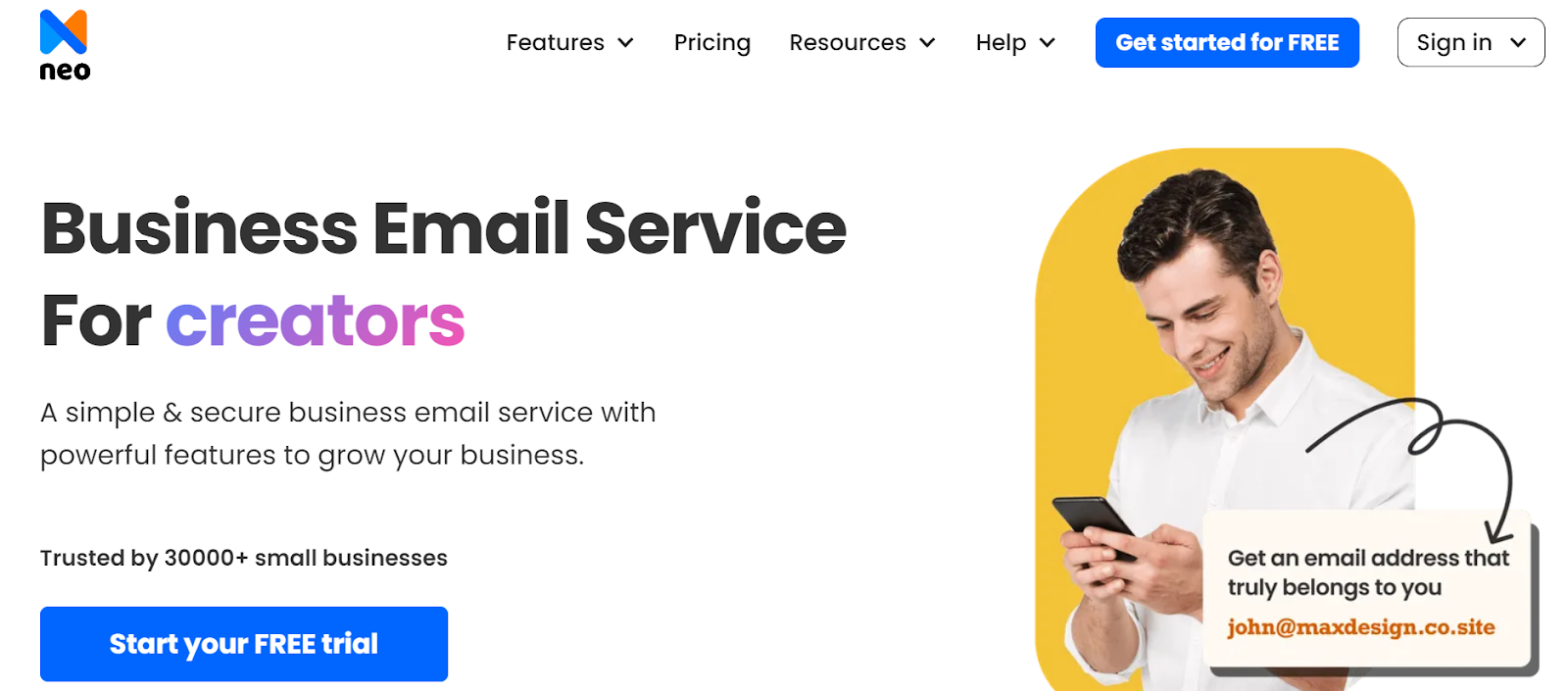
Get Business Email
No domain name required
Google Classroom has changed the way teachers and students communicate so you can stay organized and connected in one place. With built-in email features, teachers can reach out to students for updates, feedback, or reminders, and students can ask questions or submit work without the hassle of multiple platforms.
According to the reports, Google Classroom has a 10.40% share in the learning management systems (LMS) market, where it competes with 317 other tools in the category. Its top competitors are LinkedIn Learning, which is also popular.
If you are a student or teacher who wants more advanced email management options, services like Neo are quite handy. Neo is known for its user-friendly interface and offers extra email tools for schools or workplaces that want more flexibility.
This guide will cover everything you need to know about Google Classroom’s email features, from setup and notifications to private feedback and group announcements. We will also answer some questions and give a few extra tips for teachers and students to get the most out of Google Classroom.
What is Google Classroom?
Google Classroom (a part of Google Workspace for education) is a free educational tool that simplifies teacher communication with students and the sharing of resources. With this tool, teachers may conduct classes virtually, design curriculum, and distribute assignments to students without using paper records.
The platform streamlines teacher-student collaboration by utilizing Google Docs, Sheets, and Slides, among other Google Workspace applications. It was developed to enable digital learning and eliminate paper in the classroom. It was originally intended to be used with school laptops, like Chromebooks, to facilitate more effective information and assignment sharing between teachers and students.
Who Can Use Google Classroom?
Anyone with a personal Google account can use Google Classroom for free. Additionally, it is free for businesses that use Google Workspace for NGOs or Educational Institutes.
Teachers and students typically use a Google account that is issued by their school to access Google Classroom. Although Google Classroom is mostly utilized by teachers and students in schools, administrators, families, groups, after-school programs, and homeschoolers can also use some of its capabilities.
Teachers utilize its features in a variety of ways because it's a fairly adaptable platform. Google Classroom allows teachers to:
- Simplify their approach to class management: The platform interfaces with Google's other applications, including Docs, Drive, Forms, Meet, and Calendar, so there are numerous built-in "shortcuts" for classroom management tasks. For instance, your students can quickly submit an assignment to their class calendar.
- Organize, distribute, and gather student work: Teachers can also edit and reuse assignments from year to year or post them to several classes. You can reduce the amount of paper shuffle that comes with teaching and learning by using Google Classroom if your students have regular access to devices.
- Communicate with students about their assignments: The platform allows you to post announcements and assignment reminders, and it makes it simple to monitor who has completed them. Additionally, you may personally check in with each student, respond to their questions and provide assistance.
- Provide students with immediate feedback on their tests and assignments: Google Forms may be used in Google Classroom to create and distribute quizzes that are automatically graded as students submit them. In addition to saving you time when grading, your students will receive immediate feedback on their work. Teachers can access student and class data in Forms or in a Google Sheet that is created automatically.
- Record presentations: Engaging content can now be recorded in advance using Screencastify or Google Slides Recordings.
- Experiment with AI to improve productivity: Google's Duet AI assistant can help with content creation in numerous ways, including coming up with lesson ideas, adding text, charts, and images to presentations, and confirming facts and data.
Step-by-Step Guide to Set up Google Classroom for Email Communication
Google Classroom is great for teachers who want to save time teaching. For students, it is equally beneficial since they need a structured space to manage assignments and class discussions. Below is a step-by-step guide to setting up and using Google Classroom to study better!
Step 1: Setting Up Google Classroom
If you’re new to Google Classroom, here’s how to get started:
- Go to Google Classroom: Visit classroom.google.com and log in with your Google account. If your school has a Google Workspace for Education account, use that login.

- Create or Join a Class:
Teachers: Click + Create Class to set up a new class. You’ll need to fill in the class details (name, section, subject etc.) and share the class code with your students.

Students: Click + Join Class and enter the class code your teacher gave you. This will add you to the class.
Step 2: Turn on Email Notifications for Important Updates
To stay updated, turn on email notifications in Google Classroom so you get an alert whenever there’s a new announcement, assignment, or teacher feedback.
- Go to Settings: Once logged in, click the Settings icon (gear symbol) at the top right of your Classroom dashboard.

- Turn on Notifications: Scroll down to ‘Notifications’ and select which notifications you want to receive, such as Alerts when someone replies to your post or notifications when someone tags you in a post. General updates, including new assignments and announcements, can also be managed here.
If you’re in multiple classes, you can customize notifications for each one. This way, you’ll only get alerts from the specific classes.
Step 3: Use the Stream Tab for Class Communication
The Stream tab is like a class bulletin board where teachers can post updates and students can comment.
- Teacher Posts:
Teachers can post announcements, reminders, or important updates in the Stream for the whole class. This way, everyone gets the same information at the same time.
For example, teachers can post a reminder about an upcoming test or share additional resources.
- Student Comments:
Students can comment on posts if the teacher allows it, creating a space for class-wide discussions or Q&As. For instance, if students have questions about an assignment, they can ask in the Stream for everyone to see.
Settings also allow teachers to control who can post and comment. This helps keep the Stream study-focused and well-organized, as required.
Step 4: Use the Classwork Tab for Assignment Communication

The Classwork tab allows to post assignments with detailed instructions, and students can comment on each task.
- Assignment Comments:
Under each assignment, students can leave comments to ask questions or clarify instructions, and you can respond to these comments, and the whole class will be notified.
- Private Comments:
You can also add ‘Private Comments’ to assignments. These comments are only visible to the student, so they are great for feedback or answering one-on-one questions without involving the whole class.
Step 5: Email Students and Teachers Directly from Google Classroom
The People tab in Google Classroom enables you to email classmates, teachers, or the whole class if needed. This is great for private communication or for emailing multiple people at once.
- Open the People Tab:
In Google Classroom, go to the People tab to see a list of students and teachers in the class.
- Email a Classmate or Group:
Select the name(s) you’d like to email and click on the Email icon. Gmail will open with the recipient’s email address already filled in.
- Compose and Send:
Write your email, add any attachments if needed, and send it. This is great for personal communication, like reaching out to a student about missing work or sending a reminder to a group.
Step 6: Organize in Gmail
Once you’ve sent or received an email from Google Classroom, you can use Gmail’s features to stay organized:
- Reply from Gmail: You don’t have to go back to Google Classroom to respond. You can reply to Classroom emails right from your Gmail inbox.
- Use Labels: Gmail’s Labels feature is great for keeping track of different classes or subjects. You can create labels like “Math 101”, “Science Updates”, and “Classroom Assignments.” These Gmail labels are like folders that help you organize emails.
- Set Up Filters: Gmail also allows you to create filters to automatically sort or label emails based on keywords like “Google Classroom” or class names. So important updates are easy to find.
Step 7: Set Class Communication Rules
Teachers can keep communication clear and professional by setting some simple rules for email use in Google Classroom.
- Office Hours: Teachers can set times when they’ll be available to respond to emails or comments. So students know when to expect a response and can plan their questions accordingly.
- Clear Subject Lines: When emailing, encourage students to use specific subject lines like “Question about Homework” or “Need Help with Assignment”. So the teacher can quickly see what each email is about.
- Professional Language: Remind students to keep their messages respectful and professional, especially in group communication. This keeps the learning environment positive and productive.
Neo: An Affordable Alternative

Neo is the best option if you're looking for innovative solutions to develop a smart educational system. It is an affordable email hosting service that is particularly helpful for small educational institutions. Neo has several features that make classroom management easier.
Neo is an email service provider known for its cost-effective features and flexible pricing plans. Because of its advanced features, the platform may be the best alternative to other email hosting platforms. These features include:
1. Custom Email Domain
Neo provides teachers with the option to register their own email domain name while also offering a free .co.site domain extension. For instance, name.co.site. You may be sure that you will receive a school affiliated email address at a reasonable cost with Neo.
2. AI Smart Write
Smart Write is a tool powered by Gen AI that allows teachers to provide a prompt for the email, determine the tone, select a format, and press the Generate button to write an email. In just one minute, you will receive your draft version, which you can then edit and send.
3. Blazing Fast Apps
Access seamless communication with all members of the organization through webmail and applications specifically designed for desktop and mobile devices. Furthermore, Neo's enhanced turbo search feature delivers search results in a mere fraction of the time.
4. Read Receipts
This function notifies you whenever your email is opened, regardless of the time of day. This eliminates the uncertainty of waiting for a reply and allows you to strategize your next moves.
This unique function allows you to retract emails before they are delivered to the recipient's inbox. This allows you to rectify errors and share overlooked links or attachments. You have the option to adjust the undo send feature from 5 seconds to a maximum of 2 minutes.
5. Calendar
Neo's built-in calendar simplifies your scheduling right away. This calendar can also be shared with teachers, staff, and students. Anyone has the ability to check the calendar daily, weekly, or monthly to stay on top of deadlines.
6. Email Rules
With this tool, you may use customizable rules to arrange your inbox. All conversations can be categorized into folders, and related messages can be kept together for convenient access. Additionally, you can use your customized settings to filter out spam emails.
The platform also provides improved administration controls and strong security. Neo also offers scalable solutions for affordability and a free one-page website for developing your online portfolio.
Conclusion
Using Google Classroom for email communication keeps students and teachers informed, organized, and connected. Everything in one place means you can manage assignments, updates, and one-on-one communication. Email services like Neo offer additional options for those looking for extra flexibility that work well with Classroom, making it easier to manage online communication.
Whether you’re a teacher or a student, knowing how to use Google Classroom makes teaching and learning fun, engaging, and productive. It also makes it a smoother and more interactive experience.
Frequently Asked Questions (FAQs)
1. What is Google Classroom? Can students email their teacher directly through Google Classroom?
Yes, students can email their teacher directly from Google Classroom. Go to the People tab, find the teacher’s name and click the Email icon. This will open Gmail and students can compose and send their email. It is great for asking questions privately or for help.
2. Can parents get email updates through Google Classroom?
Yes, parents can stay informed about their child’s progress through Guardian Summaries. Teachers can invite parents or guardians to receive a weekly email summary of assignments, due dates, and any missing work.
3. Can I send attachments through Google Classroom emails?
Yes, when you use the email feature in Google Classroom (under the People tab), it will take you to Gmail, where you can add attachments like files, images or links to any email. It is ideal for teachers to send extra resources or for students to submit drafts for review.
4. How do I turn on/off notifications for different classes?
In Settings > Notifications you can toggle notifications on or off for each class. So you can keep notifications on for important classes and off for others and only get notified of the most important updates.

Get Business Email
No domain name required





.svg%201.svg)
.svg)
.svg)
.svg%201.svg)



